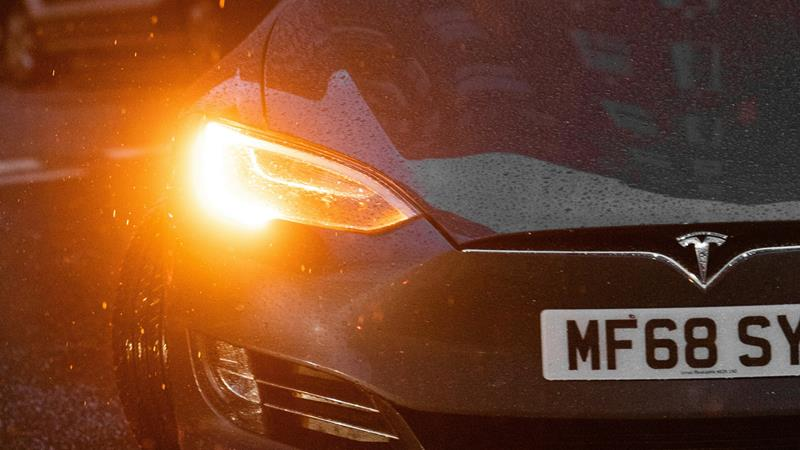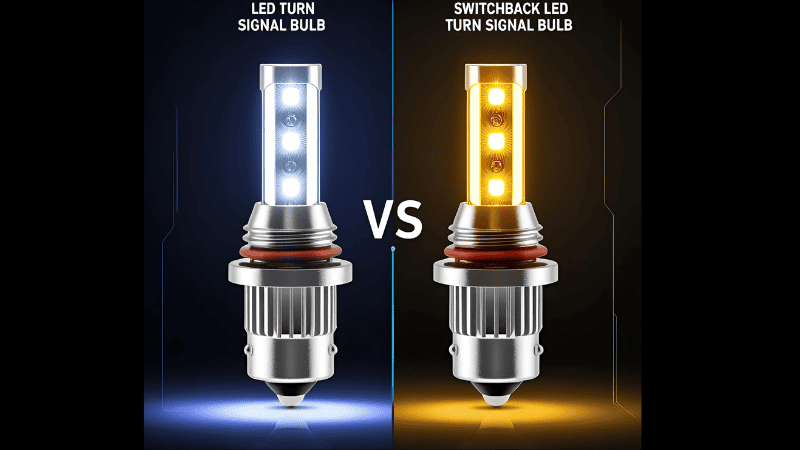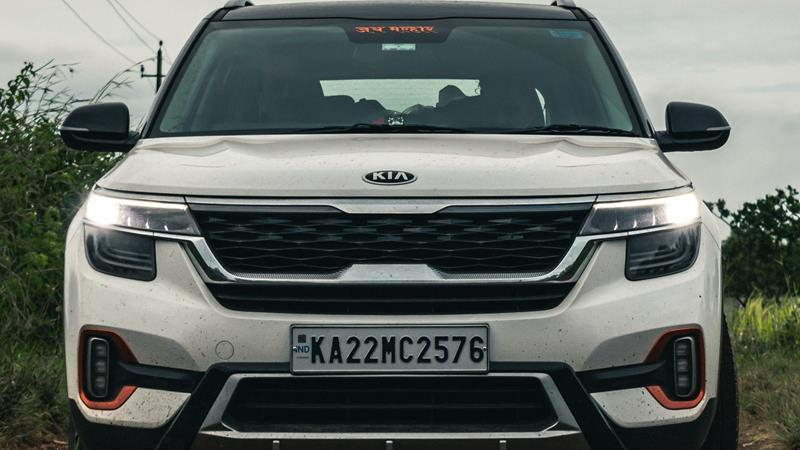According to the Federal Highway Administration, roughly 25% of traffic accident fatalities and 50% of injuries are attributed to accidents at intersections. Many of these accidents involve a turning vehicle.
Drivers and pedestrians often don’t notice all the hazards when driving through or crossing near intersections, including vehicles signaling their intention to turn. This leads to accidents.
Switchback LED lighting can improve the visibility of cars when turning. This article explains what these LED lights are and how they work. It also describes the different types of switchback bulbs and the benefits of installing them in a vehicle.
What is a Switchback LED Light?
These are LED lights that can switch between two different colors. The two colors associated with switchback LED lights are white and amber.

Switchback LED lights can change color because they have two sets of LEDs with two different colors, white and amber. There are switchback lights that blink between the two colors and those made up of rows of LEDs that change color sequentially, among others.
Presently, switchback LEDs are used as replacements for traditional turn signal bulbs, which use incandescent technology. These LED lights are brighter than the incandescent ones, improving the visibility of turning signals at road junctions.
How Does a Switchback LED Light Work?

Switchback LED lights glow white when the engine is turned on. In this mode, the lights act as daytime running lights or parking lights and stay on as long as the car is on.
When the turn signal is engaged, the switchback LEDs will alternate between the amber and white colors. The amber color will be noticeably brighter than the white to alert other drivers of your intention to turn.
Other switchback LED bulbs alternate between the bright amber light and no light in this mode. When the turn signal is engaged, the white LEDs go completely off, and the amber LEDs blink on and off to indicate the turning direction. The white light only comes on again when the turn signal is disengaged.
Circuitry and Compatibility
Switchback LED bulbs need two separate electrical circuits – one for the yellow/amber LEDs and another for the white ones. Therefore, these lights are only compatible with cars with incandescent turn signal bulbs with two filaments.

If your turn signal bulbs have two filaments each, you’ll notice that they glow with a dim amber light when the vehicle is running but blink with a brighter amber light when the turn signal is engaged. You can also remove the bulb and check if it has one or two filaments.
If the turn signal bulb has only one filament, you can’t replace it directly with a switchback LED light. However, you can still replace it with a brighter LED turn signal bulb.
LED Turn Signal Bulb Vs. Switchback LED Turn Signal Bulb

Incandescent turn signal bulbs with one filament can be replaced by LED bulbs with amber LEDs. In this case, the turn signal lights remain off unless the turn signal is engaged. It won’t be able to switch between two colors.
The advantage of the LED turn signal bulb is that drivers get brighter turn signals. However, they won’t have the running light function without the switchback LED bulbs.
Benefits of Switchback LED Lights
Installing switchback LED lights comes with several advantages. These are explained below.
1. Improved Visibility and Safety
The main benefit of switchback LED lights is that they are better at grabbing other people’s attention. This means that when the turn signal is engaged, other drivers and pedestrians will be less likely to miss it and will know that you’re turning in a particular direction.

This improved visibility is great for safety because the earlier other people know that you intend to turn, the earlier they can take the necessary steps to avoid a collision.
2. Enhanced Aesthetic Appeal
The aesthetic of switchback LEDs is very appealing to many car owners. These lights are especially suited to the look of modern cars. If you’ve been looking for ways to improve the visual appeal of your car, switchback LED lights are a good way to go.
3. Versatility
Switchback LED lighting combines two functions in the same bulb. They serve as both daytime running lights, which let other people know your car is still running even when you’re stopped, and as a brighter alternative to traditional turn signals.

Therefore, these lights help make roads safer in two different ways.
4. Energy Efficiency and Durability
A major drawback of the incandescent bulbs in regular turn signals is the technology’s poor energy efficiency. It stresses the vehicle’s electrical system more and emits more heat. This inefficiency is bad for the car’s electrical system and also shortens the lifespan of the light bulbs.
LED switchback lighting requires less energy and emits less heat. Under the right operating conditions, these bulbs can last a long time.
Types of Switchback LED Bulbs
Switchback LED light bulbs come in a few designs. The different designs are more about style than function.

1. AO Vs. AW
The first two types of switchback lights you should be aware of are Amber-Off (AO) and Amber-White(AW). This naming is a reference to the color change when the turn signal is engaged.
When in turning mode, the white LEDs in the Amber-Off lights are turned off completely while the amber LEDs alternate between an on and off state. Therefore, the light’s blinking pattern will be “amber-off-amber-off…”.
On the other hand, the Amber-White switchback bulb turns the amber and white LEDs on and off in an alternating pattern. The light’s blink pattern is, therefore, “amber-white-amber-white…”.
2. Switchback LED Strips
These light strips are made up of multiple amber and white LEDs. Like the regular switchback LED bulbs, these strips alternate between the daytime running mode, where they glow with a steady white light, and the turn signal mode, where the amber LEDs blink on and off.
The strips are designed to be flexible so they can be bent into different shapes to match different profiles. Some switchback LED light strips are also sequential, i.e., the amber LEDs can be turned on and off in a sequential pattern to create a dynamic turn signal.
3. Switchback Halos/Angel Eyes
These are made up of multiple LEDs in a fixed shape, usually a circle. They are designed to go around specific profiles and are used to accentuate headlights while serving as daytime running lights and turn signals.

Due to their fixed shapes and sizes, you should confirm that any size you select will fit around your headlight’s profile.
Tips When Installing Switchback LED Lights

Switchback LED lights are a great way to improve road safety while improving the aesthetics of your car. Unfortunately, some drivers have struggled to install them in their cars. Here are a few tips to keep in mind if you’re thinking about adding these lights to your car:
- Flip the bulb: If nothing happens when you plug in your switchback LED bulb, or if it doesn’t work correctly, try flipping it around. The LED bulb contacts must be aligned in a specific way for the bulb to work as expected.
- Check Compatibility: Not every car’s signal lights are compatible with switchback bulbs. Check the types of bulbs in your car and confirm that they are compatible before buying the bulbs.
- Look For Error-Free Bulbs: These are LED bulbs with inbuilt resistors. The resistors allow them to simulate the energy profile of incandescent bulbs. This lowers the likelihood of getting error messages from the CANbus system. Having inbuilt resistors also creates a plug-and-play experience during installation.
- Expect CANbus Issues: Unfortunately, you may get error messages from the CANbus system when you replace incandescent bulbs with LED bulbs. This can even happen with error-free bulbs. In such cases, you’ll need to install a load resistor. A rapidly blinking turn signal or hyper-flashing is an indicator of this CANbus problem.
Conclusion
Switchback LEDs are great for style but their main selling point is they make turn signals more visible to other road users. These LED lights can switch between two colors but are not compatible with all cars.
The benefits of switchback LED lights include improving road safety and your car’s aesthetic appeal. They also last longer than incandescent turn signal bulbs. There are different types of switchback LED lights, but look out for CANbus errors when you install them.
Contact Carlightvision For Error-Free Switchback LED Lights
The best switchback LED lights offer a convenient plug-and-play experience. Manufacturing these easy-to-install bulbs requires years of experience and high-quality parts that perform consistently. This is what you get from Carlightvision. We have worked with many worldwide brands to produce these kinds of LED products and you can be our next satisfied client. Reach out to us to find out more.




